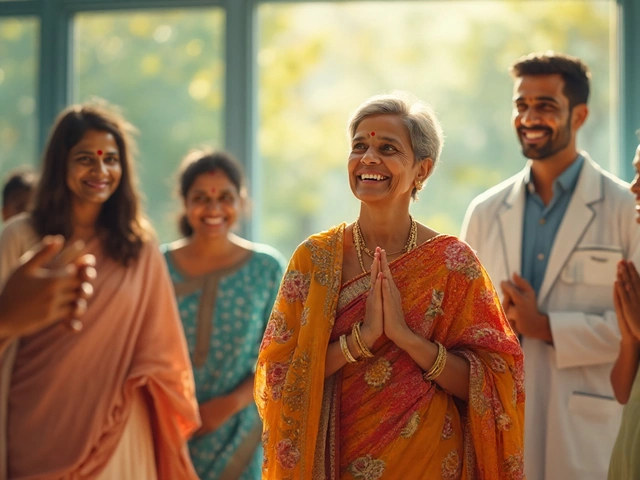
Stage 4 lung cancer packs a punch—just hearing the term can feel like a gut shot. If you or someone you care about has just heard this diagnosis, there’s no point in sugarcoating. This is the most advanced form of lung cancer, and yes, life expectancy numbers do get grim fast on Google. But is it possible to stick around for 10 years after hearing those words? Surprisingly, yes—it’s rare, but it happens more often now than it did a decade ago.
Back in the day, folks barely hoped to get more than a year or two with stage 4 lung cancer. Now, thanks to some wild leaps in medicine—like targeted therapies and immunotherapy—some people are living a lot longer. You’ll even find real stories of people making it to year ten and still ticking.
If you’re here looking for numbers, blunt truth, and practical advice (not miracle cures or empty promises), you’re in the right spot. Times are changing, and flipping the script on stage 4 lung cancer is slowly becoming a little less rare—let’s break down how, why, and what you can actually do to help your odds.
- Stage 4 Lung Cancer Basics—What Does It Actually Mean?
- The Stats: How Long Do People Usually Live?
- Stories of Long-Term Survivors
- The Latest Treatments That Change the Game
- Tips for Living Well with Advanced Lung Cancer
- How to Plan for the Unknown
Stage 4 Lung Cancer Basics—What Does It Actually Mean?
Stage 4 lung cancer is when things get serious. This is the point where cancer in the lungs has spread—either to the other lung, to fluid around the lungs or heart, or even to places like the bones, brain, liver, or adrenal glands. The technical word for this is "metastatic," which just means the cancer isn’t sticking to one spot anymore.
When a doctor says you or your loved one has stage 4 lung cancer, it means the main tumor couldn’t be contained. It broke loose, traveled through the blood or lymph system, and set up camp somewhere else. It doesn’t mean your body is giving up—it just means treatment needs a totally different strategy now.
There are two main types of lung cancer that end up at stage 4:
- Non-small cell lung cancer (NSCLC): This is by far the most common – about 80-85% of cases. It usually grows and spreads slower than the other type.
- Small cell lung cancer (SCLC): Usually spreads faster and can grow quickly, making it trickier to treat if caught late.
At stage 4, doctors focus less on trying to "cure" the cancer and more on managing it. The goals are to control symptoms, stop the cancer from growing as much as possible, and keep you feeling as good as you can for as long as possible.
Here’s a quick snapshot of what “stage 4” means in medical terms:
| Where Has Cancer Spread? | What’s the Focus? |
|---|---|
| To opposite lung, nearby fluid, or distant organs (like liver or brain) | Living longer + symptom control |
So, hearing "stage 4" is tough, but it’s not the end of the story. The new tools and treatments out there are changing the picture, even when cancer has traveled far.
The Stats: How Long Do People Usually Live?
Let’s get real about the numbers for stage 4 lung cancer. Survival rates are blunt, and usually people want to know the average first. For folks diagnosed today, the median survival is about 8 to 13 months if you look at big studies. That means half the people make it longer, half less. A lot depends on the specific cancer type—non-small cell versus small cell, and whether a mutation is driving your cancer (like EGFR or ALK).
The five-year survival rate for stage 4 lung cancer in the US hovers about 8%. But here’s the thing: averages are just that. They don’t predict your own future. Some people get lucky with new drugs tailored to their tumor. Some are unusually healthy and respond better to treatment, or their cancer grows way slower than usual.
| Time Survived After Diagnosis | Percentage of Patients |
|---|---|
| 1 year | ~25% |
| 2 years | ~10% |
| 5 years | ~8% |
| 10 years | Rare, but possible |
Men and women actually see slightly different outcomes. Women tend to survive a little longer, especially if they have non-small cell lung cancer with a treatable mutation. Smokers usually don’t fare as well as people who never smoked, but there are always exceptions.
Certain factors can help your odds for better lung cancer survival:
- Having a gene mutation like EGFR, ALK, or ROS1 (means targeted treatment might work for you)
- Overall good health and staying active as much as possible
- Being younger at diagnosis
- A strong support system and solid medical team
Don’t get stuck thinking you’re just a number. Doctors use these stats as a guide, but everyone’s cancer is different. With modern treatments, outliers—meaning those who live a lot longer than the averages—are showing up more often. So, if you want to beat the curve, it’s not impossible, just tough business.
Stories of Long-Term Survivors
When people talk about stage 4 lung cancer, most assume there’s little hope past the first couple years, but some patients flip the script entirely. There are real folks out there who buck the stats. For example, a woman named Lynda from Texas was diagnosed in 2011 with stage 4 lung cancer. On chemo and then targeted pills, she celebrated her tenth "cancerversary" in 2021 and even got to hold her first grandchild. She’s been open about her treatments, including EGFR-targeted therapy, and credits clinical trials for her longer survival.
Another well-known story is former marathon runner Steve, who went public in survivor forums after living over 8 years with stage 4 lung cancer, thanks to new immunotherapy. He started with standard chemo, then switched to immunotherapy drugs after genetic tests showed a match. Like Steve, people with certain mutations (like EGFR or ALK) have more options now, and it seriously impacts their odds.
Let’s check out some data from recent years that give these stories context:
| Year | Estimated 5-Year Survival Rate (%) |
|---|---|
| 2008 | 4.5 |
| 2015 | 6.3 |
| 2024 | 9.0 |
The truth is, these rates are going up because the treatments are better and more personalized. Targeted therapy, when it works, can sometimes keep lung cancer in check for years—letting people get back to work, travel, or just annoy their grandkids a little longer. Immunotherapy drugs, like pembrolizumab and nivolumab, are another big reason the odds are improving.
Long-term survivors aren’t just lucky. They often push to get molecular testing, join trials, and never settle for a one-size-fits-all answer. Plenty stay on top of side effects while working closely with their cancer teams. If you’re newly diagnosed or know someone who is, don’t be shy about asking for the latest treatments and even second opinions—you might just add more years to the calendar.

The Latest Treatments That Change the Game
This is where things get interesting. A while back, if you had stage 4 lung cancer, the toughest part was hearing there weren’t many good options. It was mostly chemo, which hit hard and often didn’t buy much time. Fast forward to now and the scene has totally changed, thanks to some breakthroughs you can’t ignore.
The first game-changer is targeted therapy. If your cancer has certain genetic changes—like EGFR, ALK, or ROS1—doctors can now match you up with pills that specifically attack cancer cells with these mutations. Instead of blasting your whole body, these drugs zoom in on the problem cells. Some folks take these meds for years and actually feel pretty normal, keeping the cancer in check longer than old-school chemo ever could.
Then you’ve got immunotherapy. This stuff doesn’t attack the cancer itself; it helps your own immune system notice and smash the cancer cells. The most famous versions are drugs like pembrolizumab (Keytruda) and nivolumab (Opdivo). About 1 in 5 people with advanced lung cancer see long-lasting benefits with these meds. For a slice of those folks, the cancer basically stops in its tracks for years.
These treatments can also be combined. Sometimes doctors use immunotherapy at the same time as chemo for a better punch, or even mix it up with targeted therapy if you have the right mutation. Personalized medicine—picking treatments that fit your exact cancer type—is finally a reality.
For a quick sense of how things have changed, check this out:
| Treatment | Average Survival (Years) | Who It's For |
|---|---|---|
| Standard Chemotherapy | 1 - 2 | Anyone |
| Targeted Therapy (EGFR/ALK/ROS1/others) | 2 - 5+ | Specific mutations |
| Immunotherapy (Keytruda, Opdivo) | 2 - 4+ | Tumors with certain markers |
| Combination (Chemo+Immuno) | 2 - 4 | Most patients fit |
Don’t forget about clinical trials, either. Patients who jump into new studies sometimes get access to the sharpest cancer treatment ideas before everyone else. Ask your doctor if there are trials at your hospital—you never know what might show up.
If you’re living with stage 4 lung cancer today, your treatment options are way more than just chemo, and more hope now sits on the table than ever before. It really does pay to ask about genetic testing, immunotherapy, and clinical trials. The old playbook? Toss it out. It’s a whole new ballgame.
Tips for Living Well with Advanced Lung Cancer
When you get a stage 4 lung cancer diagnosis, you’re suddenly juggling doctor visits, new medicines, and worries about the future. No guidebook covers everything, but there are solid ways to boost both your quality of life and, sometimes, even your life expectancy. Here are some real-world tips folks use to manage it all a little better:
- Stay active if you can: A quick walk or even gentle stretches can help with energy, mood, and sleep. You don’t have to run marathons—just keep moving however suits you.
- Dial in your diet: Eating enough and keeping up with proteins (chicken, beans, eggs, tofu) helps your body recover from treatments. Many cancer centers have dietitians—ask for help if food starts tasting weird or you lose your appetite.
- Get help managing symptoms: Don’t wait until pain or breathlessness gets bad. There are medications and tricks (like home oxygen for tough days) that actually work. Be vocal with your care team—this isn’t a time to tough things out in silence.
- Prioritize mental health: Anxiety and depression are super common in lung cancer. Counseling, support groups (even online ones), and sometimes medication can make a world of difference. Don’t brush this off. Ask about options early.
- Keep track of new treatments: Trials and new drugs pop up all the time for lung cancer. If your current plan isn’t working, talk with your oncologist about what’s new, including targeted therapies or immunotherapies if your cancer has certain mutations.
Here’s a quick look at how some of these daily habits stack up for folks dealing with lung cancer:
| Habit | Benefit Reported |
|---|---|
| Regular light exercise | Less fatigue, better mood |
| Eating enough protein | Better recovery from treatment |
| Symptom management | Fewer days with severe pain or shortness of breath |
| Mental health care | Lower anxiety, improved hope |
| Keeping up with new treatments | Chance of longer survival |
One more thing—don’t try to do it all by yourself. Family, friends, and even strangers can be a lifeline, whether it’s help with a ride to chemo or just someone to listen. Asking for help isn’t a sign of weakness—it’s what smart survivors do. Remember, living well with stage 4 lung cancer doesn’t just mean counting years; it’s about what you pack into the time you’ve got.
How to Plan for the Unknown
No one walks into stage 4 lung cancer knowing what tomorrow looks like. There’s no roadmap. But there are smart moves that can put you in a better spot, give you some peace, and help you feel a little less tossed around by everything.
First, get real with your medical team. Ask about your best-case, worst-case, and likely-case scenarios. Write down your questions before appointments. Don’t be shy about wanting details—they’ve heard everything before. And if you hear something that sounds confusing, ask for it again in plain English.
It’s also smart to sort out some paperwork, even if it feels awkward. These steps aren’t giving up; they’re just making sure your wishes are clear. Here’s a basic checklist:
- Appoint a health care proxy or power of attorney—a person you trust to make decisions if you can’t.
- Write out your advance directives: Do you want certain life-support treatments or not?
- Keep your will up-to-date. Double-check beneficiary info on life insurance and bank accounts.
- Organize medical info, insurance papers, and key contacts in one spot—this will help family or friends if they need to step in fast.
On the practical side, try to stay flexible. Stage 4 isn’t a straight path. Treatment plans change. Some days you might feel okay, others not so much. Even small steps—like putting a neighbor’s number on the fridge for help, or carrying a list of your meds—make things smoother.
Don’t overlook honest talks with family and close friends. No need for drama—just basics. Let them know your wishes, your fears, and what kind of help actually helps.
You might be surprised at how much these plans lower your day-to-day stress. One recent survey from the American Cancer Society found that patients with an advance care plan in place felt calmer, even when their situation didn’t improve medically.
And financially? Ask your hospital about oncology social workers or patient resource help. They can connect you with support for costs you might not even know exist—like rides to treatment or covering some medicines. Use those services. They’re there for folks walking the same path as you.
The truth is, there’s no such thing as complete preparation with lung cancer at this stage. But having some basics in order means you can make more time for living—whatever that looks like for you.





Rohan Talvani
I am a manufacturing expert with over 15 years of experience in streamlining production processes and enhancing operational efficiency. My work often takes me into the technical nitty-gritty of production, but I have a keen interest in writing about medicine in India—an intersection of tradition and modern practices that captivates me. I strive to incorporate innovative approaches in everything I do, whether in my professional role or as an author. My passion for writing about health topics stems from a strong belief in knowledge sharing and its potential to bring about positive changes.
view all postsWrite a comment